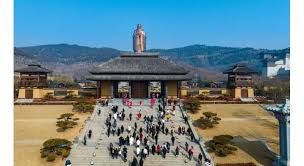Si River nurtures Confucian culture in China’s Shandong Province

Beijing: The Si River, formerly known as Sishui, belongs to one of the major rivers in ancient times.
The Si River that originates from Heiyu Mountain in Xintai City, Shandong Province, flows through seven counties and districts including Xintai, Sishui, Qufu, Yanzhou, Zoucheng, Rencheng, and Weishan, and drains into the South Four Lakes at the junction of Rencheng District and Weishan County in Jining City.
The river is 169 kilometers long,with a drainage area of 2,383.6 square kilometers.
“Time passes by like this, flowing away day and night,” Confucius once sighed by the rushing Si River,leaving a remark that has lasted for a thousand years.
For thousands of years, the Si River, with its broad embrace and surging momentum, has not only nurtured the profound Confucian culture but also attracted numerous sages, philosophers, and literati to visit here.
The five saints of Confucianism, as well as figures like Mozi and Zhongzi, either grew up here or engaged in activities here, forming an inseparable bond with the Si River.
Li Daoyuan, a geographer from the Northern Wei Dynasty, praised the Si River in his work “Shui Jing Zhu” as a renowned river of Haidai area.
The Tang Dynasty poet Li Bai traveled extensively along the Si River, leaving behind the beautiful line “The autumn waves of Si Shui brighten Culai Mountain far away.”
The Southern Song Dynasty philosopher Zhu Xi also wrote the poem “When along the Si River I seek blooms of the brilliant day, before my eyes stretches away a boundless scene of beauty.”
A glance at the visage of vernal breeze, and I know, a thousand flowers of purple and red set spring aglow.
Quanlin, an important water source upstream of the Si River, was once considered as the ancient source of the Si River.
Located 25 kilometers east of Sishui City, at the foot of Peiwai Mountain,Quanlin is at the edge of the Taiyi low mountain hills,where various springs converge to form a spectacular spring group.
Quanlin is named for its abundant famous springs, with numerous springs as dense as a forest, earning it a reputation throughout the world.
The spring group boasts seventy-two famous springs, dozens of large springs, and countless small springs, making it a brilliant pearl embedded in the eastern part of the homeland of Confucius and Mencius, hailed as “the crown of springs in Shandong.”
With its beautiful natural water scenery,
Quanlin has attracted many literati, emperors, and generals through the ages, leaving behind a wealth of poems appreciating the springs.
This place features green willows, lush grass, bubbling spring like pearls, and floating water algae, creating a picturesque scene that is naturally captivating and beloved by people.
During his southern tour, Emperor Kangxi of the Qing Dynasty passed through Quanlin and wrote “Record of Quanlin,” praising it as “a place with superior springs, where sacred traces remain.”
Today, the Si River Haidai Mingchuan Park and Si River Longwan Lake Art Town have been built along the banks of the Si River,where the charm of art perfectly merges with the vitality of water.
In addition to appreciating various artworks,the idyllic rural scenery resembling a paradise makes people linger and forget to leave.





